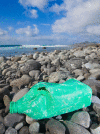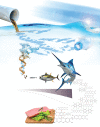New link in the food chain? Marine plastic pollution and seafood safety
- PMID: 25643424
- PMCID: PMC4314237
- DOI: 10.1289/ehp.123-A34
New link in the food chain? Marine plastic pollution and seafood safety
Erratum in
-
Erratum: "New Link in the Food Chain? Marine Plastic Pollution and Seafood Safety".Environ Health Perspect. 2016 Jul 1;124(7):A123. doi: 10.1289/EHP465. Environ Health Perspect. 2016. PMID: 27479989 Free PMC article. No abstract available.
Figures








References
-
- EPA. Bisphenol A (BPA) Action Plan Summary [website]. Washington, DC:U.S. Environmental Protection Agency (updated 29 January 2014). Available: http://www.epa.gov/oppt/existingchemicals/pubs/actionplans/bpa.html [accessed 28 January 2015]
-
- Deanin RD. Additives in plastics. Environ Health Perspect. 1975;11:35–39. http://www.ncbi.nlm.nih.gov/pmc/articles/PMC1475198/ - PMC - PubMed
Publication types
MeSH terms
Substances
LinkOut - more resources
Full Text Sources
Medical

